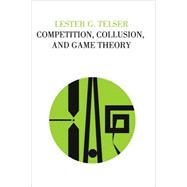
Note: Supplemental materials are not guaranteed with Rental or Used book purchases.
Purchase Benefits
What is included with this book?
| Foreword | p. vii |
| Acknowledgments | p. xi |
| Introduction | p. xiii |
| Applications of Core Theory to Market Exchange | p. 3 |
| Introduction | p. 3 |
| Consumer Surplus and Transferable Utility | p. 4 |
| Some Simple Trading Situations | p. 11 |
| m Owners and n Nonowners | p. 19 |
| The Basic Core Constraints | p. 28 |
| Market Efficiency and Honest Brokers | p. 31 |
| Multiunit Trade | p. 37 |
| Increasing Returns and Public Goods from the Viewpoint of the Core | p. 48 |
| A Brief Historical Note | p. 57 |
| Consumer Surplus | p. 62 |
| Further Applications of Core Theory to Market Exchange | p. 68 |
| Introduction | p. 68 |
| Balanced Collections of Coalitions | p. 70 |
| Empty Cores | p. 78 |
| The Feasibility of Trade | p. 88 |
| Group Rationality with Multiunit Trade | p. 94 |
| Competition and Numbers | p. 104 |
| The Number of Traders and the Emptiness of the Core | p. 108 |
| Conclusions | p. 117 |
| Applications of the Core to Oligopoly | p. 119 |
| Introduction | p. 119 |
| Properties of the Core under Constant Returns | p. 124 |
| The Cournot-Nash Theory of Duopoly for Finite Horizons | p. 131 |
| The Cournot-Nash Theory of Duopoly for Infinite Horizons | p. 142 |
| Theories of Expectations for N Competing Firms | p. 146 |
| Introduction | p. 146 |
| Expectation Models with Quantity as the Policy Variable | p. 149 |
| Expectation Models for Price as the Policy Variable | p. 164 |
| Summary | p. 172 |
| Competition or Collusion? | p. 175 |
| Introduction | p. 175 |
| The Nature of Competition and Collusion | p. 176 |
| Equilibrium with Product Variety Illustrated for Spatial Competition | p. 184 |
| The Costs of Maintaining Collusion | p. 192 |
| Sharing the Collusive Return | p. 206 |
| The Monopoly and Cournot-Nash Equilibria under Dynamic Conditions | p. 218 |
| Introduction | p. 218 |
| Dynamic Demand Relations | p. 221 |
| Some Fundamentals on Optimal Policies | p. 226 |
| The Solvability of Certain Linear Equations | p. 242 |
| Properties of the Cooperative and Noncooperative Dynamic Equilibria | p. 250 |
| Conclusions | p. 272 |
| Estimates of Demand, Price Policy, and the Ratio of Price to Marginal Cost by Brand for Selected Consumer Goods | p. 274 |
| Introduction | p. 274 |
| Estimates of the Demand Relation between Market Share and Prices | p. 283 |
| Estimates of the Relations among Competing Prices | p. 294 |
| Competition in a New Product | p. 299 |
| Conclusions | p. 305 |
| Some Determinants of the Returns to Manufacturing Industries | p. 312 |
| Introduction | p. 312 |
| Description of the Data and Some Simple Summary Statistics | p. 316 |
| Multiple Regression Analysis of the Census Data | p. 324 |
| An Analysis of Employment Turnover in Selected Manufacturing Industries | p. 339 |
| A Brief Survey of Findings by Other Investigators | p. 352 |
| Conclusions | p. 356 |
| Estimation of Payrolls, Annual Earnings, and Employment of Nonproduction Workers | p. 357 |
| Description of the Samples | p. 359 |
| The Two-Digit Industry Effects | p. 361 |
| The Relative Size Distribution of Firms | p. 363 |
| References | p. 367 |
| Name Index | p. 371 |
| Subject Index | p. 372 |
| Table of Contents provided by Ingram. All Rights Reserved. |
The New copy of this book will include any supplemental materials advertised. Please check the title of the book to determine if it should include any access cards, study guides, lab manuals, CDs, etc.
The Used, Rental and eBook copies of this book are not guaranteed to include any supplemental materials. Typically, only the book itself is included. This is true even if the title states it includes any access cards, study guides, lab manuals, CDs, etc.